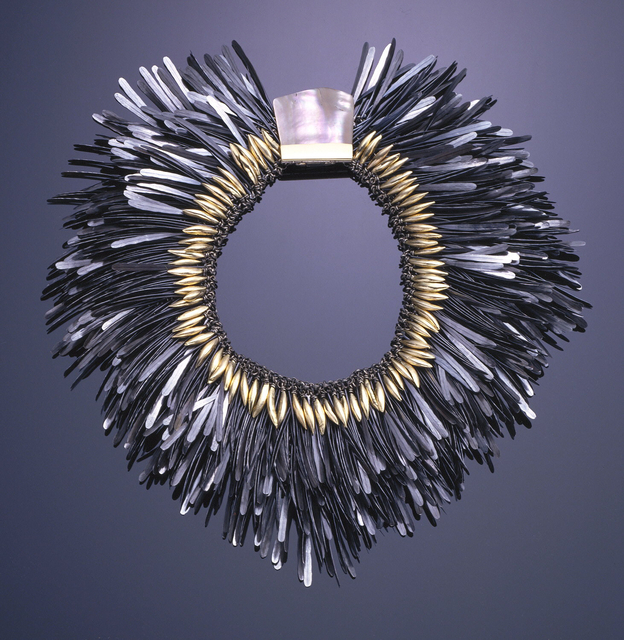On first glance, this necklace by the Norwegian jeweler and metalwork artist Tone Vigeland, appears to be a luxurious collar made of delicate, lustrous blue-black feathers. It is actually an intricate tour de force in metals, composed of hundreds of steel nails that Vigeland flattened and forged by hand, then meticulously attached one by one to a silver chainmail backing, and embellished with a ring of gold pod-like beads and a simple rose-colored mother-of-pearl clasp. The result of Vigeland’s experimentation with metals and precise construction, this necklace is a very sensual piece in an unlikely combination of materials.
Tone Vigeland was born to a family of artists, including her father, a painter, and her great uncle, the internationally recognized sculptor Gustav Vigeland. She studied metalwork at the Norwegian Art College, and the Oslo Technical School for Jewelers, reaching master status in 1962. She also apprenticed at the Plus Center for Arts and Crafts in Fredrikstad, Norway, where she created jewelry for commercial production, in the Scandinavian Modern style—simple, bold and elegant forms without applied decoration. But by 1961, she established her own studio to create unique works, and over the next three decades explored ways to achieve flexibility in her jewelry that would correspond to movement of the body. She studied the intricate joining of Indian jewelry, and experimented with linking tiny silver rings to form pliant mesh, making reference to both chainmail and lace. Developing a uniquely personal style, she also began to incorporate found pieces of weathered iron and other metals, mixing humble and precious materials to achieve new textures and surface effects. “The way I got the idea for the feather series was pure luck. A friend…came to me with a set of black iron nails. I found that when I hammered them flat, they had a lovely character—almost like black feathers. So in this case, first I discovered the material, and then I found the design to suit it.”[1]
Having had the pleasure of studying Cooper-Hewitt’s necklace and preparing it for display several times, I can appreciate that it is far more than a small sculpture. Although the whole is somewhat heavy, it moves with a supple fluidity, almost like a garment. It is easy to imagine this piece resting gracefully on a wearer’s neck and shoulders; the individual “feathers” and hollow “pods” combed into place when still, yet responding to each movement, shifting with a soft, low clink. Vigeland’s jewelry does not just decorate the body, but is meant to interact with it.
- Asman, David. “Bringing Drama to Jewelry.” Scanorama, the Magazine of SAS, July-August, 1983, p. 82
